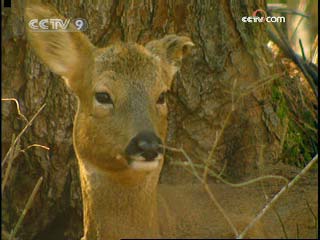------Program code: NS-080819-01704 (what's this?)
Source: CCTV.com
08-19-2008 09:37
Having only recently sprouted from the ground, this young Korean pine is about to suffer through its first winter.
 |
The King of Korean Pines, a survivor of 480 winters, is a reassuring presence beside the young pine.
The volcano on Mount Changbai used to erupt frequently. 305 years ago, one eruption filled the valleys with blistering lava, destroying all life in the area. Virtually the only survivor was the King of Korean Pines.
 |
These days Lake Tianchi, with its waters 300 metres deep inside the mountain, is calm.
60% of the Korean pines in the world are found in China. The largest concentrations are on and around the Changbai and Lesser Xing'an Mountains in the Northeast.
The vast areas of broad-leaf forests on the Changbai Mountains have been nurtured by volcanic ash. 300 years has turned devastation into rich vegetation.
A northwesterly wind rages over the Changbai Mountains, and the temperature drops to zero. The yellow leaves swirl to the ground in the forests, announcing that autumn is nearing its end.
Some of the leaves on the ground serve as food for the herbivores. But most will be covered by snow throughout the winter. In spring, they will rot and form a layer of humus – a source of nutriment for the surrounding forests.
By the time almost all the leaves have fallen, food has become scarce. The forest dwellers begin to turn their attention to the food dangling from the Korean pines.
The cones also attract some guests from more distant parts — hawfinches from the south.
A Korean pine blossoms and bears fruit once every 80 years. It takes 2 years for the nuts to ripen.
A black bear shakes the trunk, eager for an early dinner.
But the cones don’t fall as he hopes. The black bear will have to wait a little longer. Everything here has its season.
Patience is an essential virtue for every forest dweller.
In late autumn, some unexpected visitors arrive in the forests. They have come in search of wild ginseng, which is found only in broad-leaf and Korean pine mixed forests.
This is the season when the ginseng ripens. The plants are highly conspicuous against the green background.
Using knives made from deer ribs, the gatherers remove the earth from the ginseng roots. In traditional Chinese medicine, it’s believed that the value of ginseng is reduced if it’s cut with metal tools.
In late September, the first snow falls on the peaks of the Changbai Mountains.
The plateau pikas have gained enough fat. Now they can enjoy the last sunshine in the snow.
The snow caps on the mountain grow bigger and bigger as the days pass. Winter is at the door.
The broad-leaf trees around the King of Korean Pines have shed almost all of their leaves.
The pine cones on the tree’s crown are ripe after two years of growth. They fall to the ground to start the cycle of reproduction.
The animals rush into action to deal with the cones.
Cones have hard shells. They aren’t broken, even by the 30 metre fall from the tree’s crown. If the pine nuts don’t break away from the cone, it won’t sprout. However, the Korean pines have some help from the animals.
The pine nuts give off a dense fragrance, which is an irresistible temptation to the animals.
Each creature has its own ingenious way of opening the hard shell.
The grey squirrels use their sharp teeth, which are perfectly suited to cracking it open.
The chipmunks find it too big, so they study it carefully before settling down to work.
The hawfinches have very strong beaks. They can snap up one nut at each peck.
The Eurasian nutcrackers use their long beaks to open the shell, as if with pliers.
Even the paridaes are drawn to the feast, even though their usual diet consists mainly of insects.
And so the Korean pine nut banquet begins.
After eating their fill, the chipmunks scrub their mouths on the tundra belt to remove the pine oil.
Meanwhile, the nuthatches are preoccupied with storing the nuts in cracks in the tree trunks for the winter.
Editor:Yang
